Related Research Articles

Jet Propulsion Laboratory (JPL) is a federally funded research and development center in La Cañada Flintridge, California, United States. Founded in 1936 by Caltech researchers, the laboratory is now owned and sponsored by the National Aeronautics and Space Administration (NASA) and administered and managed by the California Institute of Technology.

The Mariner program was conducted by the American space agency NASA to explore other planets. Between 1962 and late 1973, NASA's Jet Propulsion Laboratory (JPL) designed and built 10 robotic interplanetary probes named Mariner to explore the inner Solar System - visiting the planets Venus, Mars and Mercury for the first time, and returning to Venus and Mars for additional close observations.

Pioneer 11 is a NASA robotic space probe launched on April 5, 1973, to study the asteroid belt, the environment around Jupiter and Saturn, the solar wind, and cosmic rays. It was the first probe to encounter Saturn, the second to fly through the asteroid belt, and the second to fly by Jupiter. Later, Pioneer 11 became the second of five artificial objects to achieve an escape velocity allowing it to leave the Solar System. Due to power constraints and the vast distance to the probe, the last routine contact with the spacecraft was on September 30, 1995, and the last good engineering data was received on November 24, 1995.
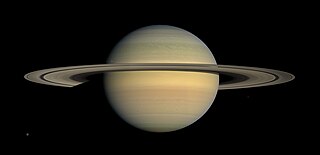
Saturn is the sixth planet from the Sun and the second-largest in the Solar System, after Jupiter. It is a gas giant with an average radius of about nine-and-a-half times that of Earth. It has only one-eighth the average density of Earth, but is over 95 times more massive. Even though Saturn is nearly the size of Jupiter, Saturn has less than one-third of Jupiter's mass. Saturn orbits the Sun at a distance of 9.59 AU (1,434 million km) with an orbital period of 29.45 years.

Cassini–Huygens, commonly called Cassini, was a space-research mission by NASA, the European Space Agency (ESA), and the Italian Space Agency (ASI) to send a space probe to study the planet Saturn and its system, including its rings and natural satellites. The Flagship-class robotic spacecraft comprised both NASA's Cassini space probe and ESA's Huygens lander, which landed on Saturn's largest moon, Titan. Cassini was the fourth space probe to visit Saturn and the first to enter its orbit, where it stayed from 2004 to 2017. The two craft took their names from the astronomers Giovanni Cassini and Christiaan Huygens.

Iapetus is the outermost of Saturn's large moons. With an estimated diameter of 1,469 km, it is the third-largest moon of Saturn and the eleventh-largest in the Solar System. Named after the Titan Iapetus, the moon was discovered in 1671 by Giovanni Domenico Cassini.

A gravity assist, gravity assist maneuver, swing-by, or generally a gravitational slingshot in orbital mechanics, is a type of spaceflight flyby which makes use of the relative movement and gravity of a planet or other astronomical object to alter the path and speed of a spacecraft, typically to save propellant and reduce expense.

Enceladus is the sixth-largest moon of Saturn and the 19th-largest in the Solar System. It is about 500 kilometers in diameter, about a tenth of that of Saturn's largest moon, Titan. It is mostly covered by fresh, clean ice, making it one of the most reflective bodies of the Solar System. Consequently, its surface temperature at noon reaches only −198 °C, far colder than a light-absorbing body would be. Despite its small size, Enceladus has a wide variety of surface features, ranging from old, heavily cratered regions to young, tectonically deformed terrain.

This article provides a timeline of the Cassini–Huygens mission. Cassini was a collaboration between the United States' NASA, the European Space Agency ("ESA"), and the Italian Space Agency ("ASI") to send a probe to study the Saturnian system, including the planet, its rings, and its natural satellites. The Flagship-class uncrewed robotic spacecraft comprised both NASA's Cassini probe, and ESA's Huygens lander which was designed to land on Saturn's largest moon, Titan. Cassini was the fourth space probe to visit Saturn and the first to enter its orbit. The craft were named after astronomers Giovanni Cassini and Christiaan Huygens.

Carolyn C. Porco is an American planetary scientist who explores the outer Solar System, beginning with her imaging work on the Voyager missions to Jupiter, Saturn, Uranus and Neptune in the 1980s. She led the imaging science team on the Cassini mission in orbit around Saturn. She is an expert on planetary rings and the Saturnian moon, Enceladus.
An extraterrestrial vortex is a vortex that occurs on planets and natural satellites other than Earth that have sufficient atmospheres. Most observed extraterrestrial vortices have been seen in large cyclones, or anticyclones. However, occasional dust storms have been known to produce vortices on Mars and Titan. Various spacecraft missions have recorded evidence of past and present extraterrestrial vortices. The largest extraterrestrial vortices are found on the gas giants, Jupiter and Saturn; and the ice giants, Uranus and Neptune.
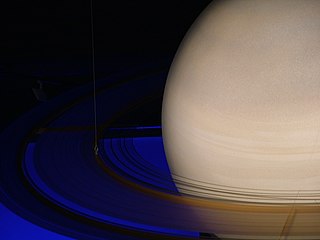
The exploration of Saturn has been solely performed by crewless probes. Three missions were flybys, which formed an extended foundation of knowledge about the system. The Cassini–Huygens spacecraft, launched in 1997, was in orbit from 2004 to 2017.
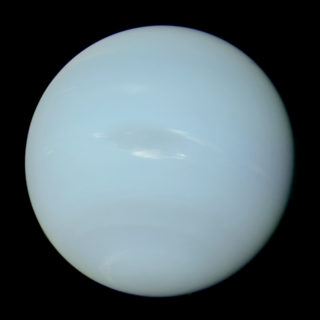
Neptune has been directly explored by one space probe, Voyager 2, in 1989. As of 2024, there are no confirmed future missions to visit the Neptunian system, although a tentative Chinese mission has been planned for launch in 2024. NASA, ESA, and independent academic groups have proposed future scientific missions to visit Neptune. Some mission plans are still active, while others have been abandoned or put on hold.
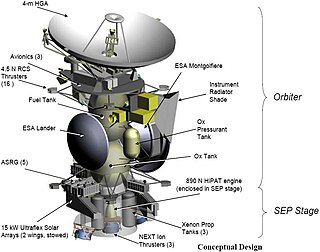
Titan Saturn System Mission (TSSM) was a joint NASA–ESA proposal for an exploration of Saturn and its moons Titan and Enceladus, where many complex phenomena were revealed by Cassini. TSSM was proposed to launch in 2020, get gravity assists from Earth and Venus, and arrive at the Saturn system in 2029. The 4-year prime mission would include a two-year Saturn tour, a 2-month Titan aero-sampling phase, and a 20-month Titan orbit phase.
JunoCam is the visible-light camera/telescope onboard NASA's Juno spacecraft currently orbiting Jupiter. The camera is operated by the JunoCam Digital Electronics Assembly (JDEA). Both the camera and JDEA were built by Malin Space Science Systems. JunoCam takes a swath of imaging as the spacecraft rotates; the camera is fixed to the spacecraft, so as it rotates, it gets one sweep of observation. It has a field of view of 58 degrees with four filters.
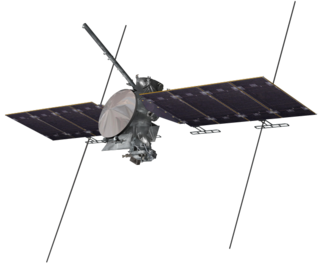
Europa Clipper is a space probe in development by NASA. Planned for launch in October 2024, the spacecraft is being developed to study the Galilean moon Europa through a series of flybys while in orbit around Jupiter. It is the largest spacecraft NASA has ever developed for a planetary mission.
Journey to Enceladus and Titan (JET) is an astrobiology mission concept to assess the habitability potential of Enceladus and Titan, moons of Saturn.
Life Investigation For Enceladus (LIFE) was a proposed astrobiology mission concept that would capture icy particles from Saturn's moon Enceladus and return them to Earth, where they could be studied in detail for signs of life such as biomolecules.

Amanda R. Hendrix is an American planetary scientist known for her pioneering studies of solar system bodies at ultraviolet wavelengths. She is a senior scientist at the Planetary Science Institute. Her research interests include moon and asteroid surface composition, space weathering effects and radiation products. She is a co-investigator on the Cassini UVIS instrument, was a co-investigator on the Galileo UVS instrument, is a Participating Scientist on the Lunar Reconnaissance Orbiter LAMP instrument and is a Principal Investigator on Hubble Space Telescope observing programs. As of 2019, she is also the co-lead of the NASA Roadmaps to Oceans World Group.
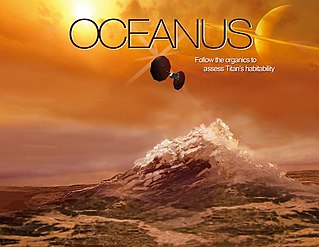
Oceanus is a NASA/JPL orbiter mission concept proposed in 2017 for the New Frontiers mission #4, but it was not selected for development. If selected at some future opportunity, Oceanus would travel to Saturn's moon Titan to assess its habitability. Studying Titan would help understand the early Earth and exoplanets which orbit other stars. The mission is named after Oceanus, the Greek god of oceans.
References
- 1 2 3 4 5 "Dr. Candice Hansen". Planetary Science Institute. Retrieved 2019-02-09.
- 1 2 3 4 Niebur, Susan (2011-01-04). "Candice Hansen: Get involved with an instrument team". Women in Planetary Science: Female Scientists on Careers, Research, Space Science, and Work/Life Balance. Retrieved 2019-02-09.
- 1 2 3 "Dixie Forum hosts presentation on Cassini mission to Saturn" . Retrieved 2019-02-09.
- ↑ "Department of Physics and Astronomy - Bullitt Lecture 2017". www.physics.louisville.edu. Retrieved 2019-02-09.
- ↑ MSFC, Jennifer Wall. "NASA - Overcoming Obstacles on Earth and in Space". www.nasa.gov. Retrieved 2019-02-09.
- 1 2 "Awards for Excellence - 2002". Solar System Exploration: NASA Science. Retrieved 2019-02-09.
- ↑ Malik, Tariq; March 9, Space com Managing Editor |; ET, 2006 12:57pm (9 March 2006). "Cassini Finds Signs of Liquid Water on Saturn's Moon". Space.com. Retrieved 2019-02-09.
{{cite web}}:|first2=has generic name (help)CS1 maint: numeric names: authors list (link) - 1 2 NASA. "NASA Cassini Spacecraft Captures Ocean-Like Spray at Saturn Moon". www.prnewswire.com (Press release). Retrieved 2019-02-09.
- 1 2 "The Edward Stone Award Recepients(sic) | Science and Technology". scienceandtechnology.jpl.nasa.gov. Retrieved 2019-02-09.
- 1 2 3 4 "PSI's Hansen-Koharcheck Honored By NASA For JunoCam Project Leadership". www.spaceref.com. 30 August 2018. Retrieved 2019-02-09.[ permanent dead link ]
- ↑ "HiRISE | About Us: Principal and Co-Investigators". www.uahirise.org. Retrieved 2019-02-09.
- ↑ "Grooves in Mars dunes likely from dry ice, not water". Futurity. 2013-06-17. Retrieved 2019-02-09.
- ↑ "Mars – UAPress". 12 July 2017. Retrieved 2019-02-09.
- ↑ "Meet the scientist behind these stunning images of Jupiter". PBS NewsHour. 2018-09-11. Retrieved 2019-02-09.
- ↑ Stirone, Shannon. "The Woman Who Sees Space First – Space Time". Medium. Retrieved 2019-02-09.
- ↑ Gill, Victoria (2018-12-13). "Juno snaps giant Jupiter polar storms" . Retrieved 2019-02-09.
- ↑ Orton, Glenn S.; Hansen, Candice; Caplinger, Michael; Ravine, Michael; Atreya, Sushil; Ingersoll, Andrew P.; Jensen, Elsa; Momary, Thomas; Lipkaman, Leslie (2017). "The first close-up images of Jupiter's polar regions: Results from the Juno mission JunoCam instrument". Geophysical Research Letters. 44 (10): 4599–4606. Bibcode:2017GeoRL..44.4599O. doi:10.1002/2016GL072443. ISSN 1944-8007. S2CID 133963617.
- ↑ Ellis, Emma Grey (2016-09-02). "NASA's Juno Spacecraft Discovers Curiosities at Jupiter's Poles". Wired. ISSN 1059-1028 . Retrieved 2019-02-09.
- ↑ "Juno mission captures images of volcanic plumes on Jupiter's moon Io". Southwest Research Institute. 2018-12-31. Retrieved 2019-02-09.
- ↑ redazione (3 January 2019). "Eruzione vulcanica su "Io", la luna di Giove: lo spettacolo visibile dallo spazio" (in Italian). Retrieved 2019-02-09.
- ↑ "G.K. Gilbert Award". GSA Planetary Geology Division. Retrieved 19 September 2023.